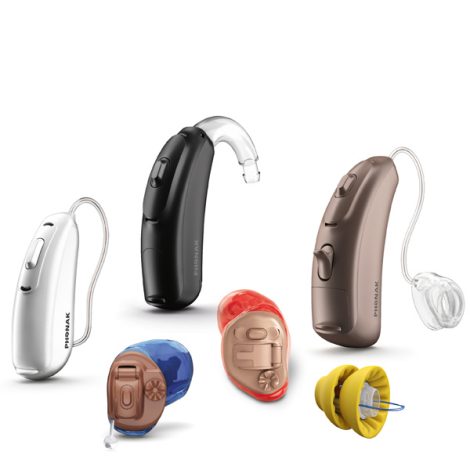At The Nottingham Hearing Practice, we know that the hearing aids you wear are incredibly important. We only supply the very best hearing aids from the world’s best manufacturers – as no one ear or loss is the same, we recognise the importance of providing our patients with a bespoke solution. As an independent hearing aid provider, we have complete freedom to recommend the best digital hearing aids to suit your needs.

There is a range of different hearing aid styles available, including Invisible in the ear (IIC), Receiver in the Canal (RIC) and Behind the Ear (BTE) hearing aids, so what’s the difference, and which hearing aid is right for you.
Fit snugly in your ear and recent miniaturization means we have space for wireless ear-to-ear operation, automatic noise sensing & remote control. These are bespoke, made to measure hearing instruments, designed and customised for your ear. Suitable for mild- to severe hearing loss. (Try the PHONAK B90 TITANIUM or LYRIC 3.1)
The most popular hearing aid form; an RIC is a discreet, mini behind-the-ear hearing solution that uses a wire and a tiny speaker in the ear canal to deliver targeted amplification. This provides more natural sound and less occlusion (‘blocked ear’ feeling) than a traditional BTE aid. Suitable for mild- to severe hearing loss. (Try the PHONAK AUDEO B90 10): NOW AVAILABLE IN LITHIUM-ION RECHARGEABLE and BLUETOOTH STREAMING VERSIONS.
These are traditional hearing instruments that sit at the back of your outer ear. Sound passes through a tube to a comfortable custom ear mould. Usually prescribed for severe- to profound and complex hearing loss. (Try the PHONAK BOLERO V50).
An advanced RIC hearing aid that connects to your smartphone. Listen to calls in stereo; stream music and TV directly to your ears and adjust your hearing preferences on your phone. Suitable for mild- to severe hearing loss. (Try the OTICON OPN 1)
Hearing aids are also available in a number of different technology levels. Typically manufacturers use four levels, loosely termed as basic, standard, advanced and premium. A basic hearing aid will still use the latest technology, but will have less features and hence tends to be designed for people who are relatively inactive, who need help in less complex listening situations.
On the opposite end of the spectrum, premium hearing aids deliver all of the latest features. They are designed to handle the most complex listening situations, deliver the most natural sound quality and best speech clarity.
All modern hearing aids will have a mixture of different features, so hearing aids can be programmed by your audiologist to ensure you get the most out of them for your lifestyle. The easiest way to explain hearing aid features is almost like the Apps on your iPhone/ Smartphone, which all have a different purpose!
Copyright © Alan H. Jackson 2019. All Rights Reserved.